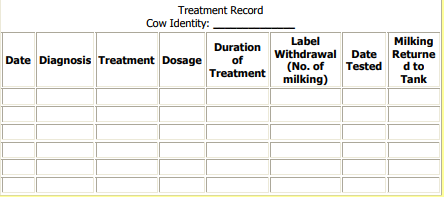The choice of drug and route of administration are determined by: the disease, the species, breed, size, etc. Different routes can be used for administering a drug.
Routes of Administration
External Application
- Injuries to, and disease of the skin, eye, ear and nose
- External parasites
Cattle
- Plunge dip
- Spray-races
- Hand spraying
- Hand dressing
- Pour-on solution
Sheep
- Plunge dipping
- Foot-and belly dipping
Horses
- Dip or spray
- Hand spraying
- Dusting with dip powders
Oral Administration
- By means of food or water
- By means of a tablet pistol Dosing of fluids by means of a dosing syringe
- Drenching by means of a stomach tube
Injections
- Subcutaneous
- Intramuscularly
- Intravenous
- Intra-mammary
- Intra-vaginal and intra- uterine
- Rectal
Now you are familiar with the routes of administration. In the following section the treatment of dairy cattle will be discuss. Livestock medicines are an important tool in the treatment and prevention of diseases. Correct treatment methods assure the safety of food products and insure an effective response to treatment.
Consider the following points before treating dairy cattle.
Drug Selection
Select the correct therapy. Consult your veterinarian for advice on the correct medication, the route of treatment, the treatment dosage, the time between treatments and the number of treatments. Veterinarians should leave clear written instructions with the herd owner identifying the treated animal and giving information on the treatment protocol. The veterinarian also plays an important role in monitoring the response to treatment.

Treatment Method
Treatment must be given correctly to be effective and to prevent complications. Use the following guidelines to develop good treatment habits.
- Wash your hands before and after handling livestock medicines.
- Use proper equipment: Choose the correct syringe and needle size for the dosage and the type of injection to be given.
- For intramuscular injection use an I 1/2", 16 or 18-gauge needles to insure the drug reaches into the muscle and not just under the skin. Before injecting, pull back on the plunger to insure the needle tip is not in a blood vessel. Select appropriate injection sites with the help of your veterinarian. Read the label for the maximum amount to be injected in one site.
- For subcutaneous injection use a 1/2" to 1", 16 or 18-gauge needles. Check that the needle tip is moveable. Inject a small amount of drug to see if a bulge is formed in the area of the needle tip. This will verify that the needle is under the skin and not in the muscle. Inject only in sites recommended by your veterinarian.
- Inject only in clean body sites.
- Use clean equipment. Singly used, sterile, disposable needles and syringes are preferred.
- Give repeated injections in different body sites.
- Before infusing antibiotics into the udder, wash the teat and your hands and dry with singly used paper towels. Disinfect the teat with an alcohol swab provided in the medication package. Avoid touching the infusion canula at the end of the treatment tube. Only use single dose infusion products in disposable syringes. Dip the teat after infusion of medication.
Dosage Calculation
To calculate the correct dosage, you must know the weight of the animal and the dosage rate. For example, treat a 600kg cow with procaine penicillin. Prescription on the label: dosage = 2.5 ml per 100 kg of body weight once a day. Calculation: 600 kg bodyweight divided by100 x 2.5 ml = 15 ml.
One millilitre (ml) and one cubic centimetre (cc) represent the same volume and are interchangeable in calculating drug dosages.
Treatment Records
Many antibiotic residue violations result from failure to: identify treated cows, maintain treatment records and use proper milk withholding times. Identify treated cows in a manner that she is clearly visible when entering the milking parlour. Some of the commonly used methods are:
- Leg bands,
- Coloured tape or fluorescent hockey tape around the legs or tail, or
- Paint markings on the cow's flank, rump or legs
In larger herds identification may be colour coded to show the last day to withhold milk. In tie-stall barns where cows always occupy the same stall, coloured tape or tags attached to the milk inlet of the pipeline can identify a treated animal.
Walls constructed of "white board" on with special markers are an excellent way to create a very large bulletin board. The identity of all treated cows and the date and time of the last withholding of milk should be clearly visible.
Keep a permanent, detailed treatment record for reference and management purposes. Write this in the herd’s health book or in the individual cow record files. This record should identify the animal, the product and dosage administered the date of treatment and the milk-withholding period. Before shipping any animal for slaughter, check this record to insure pre-slaughter treatment withholding requirements are met.
Here is an example of a record card:

Correct usage of livestock medicines, recording of treatments, and clearly identifying treated cows are essential practices.